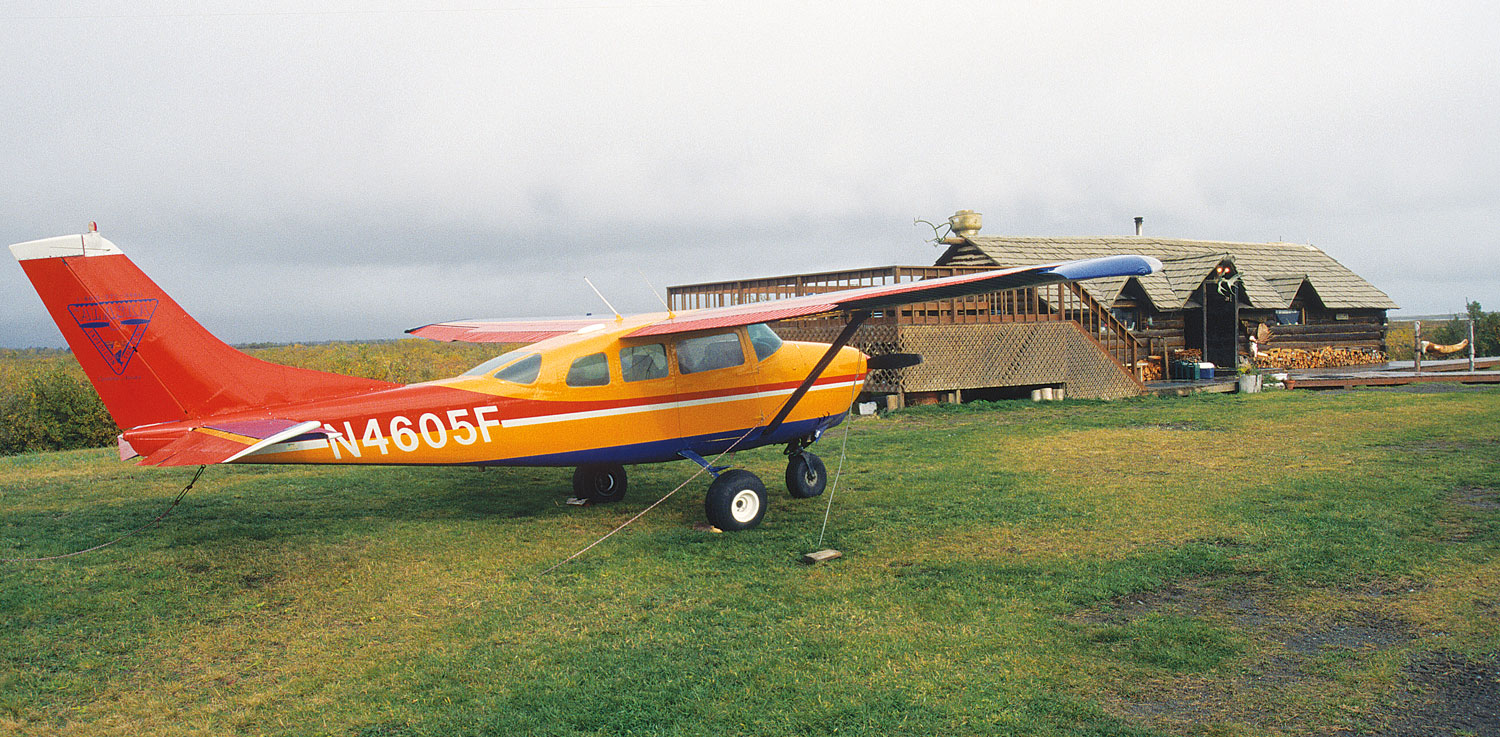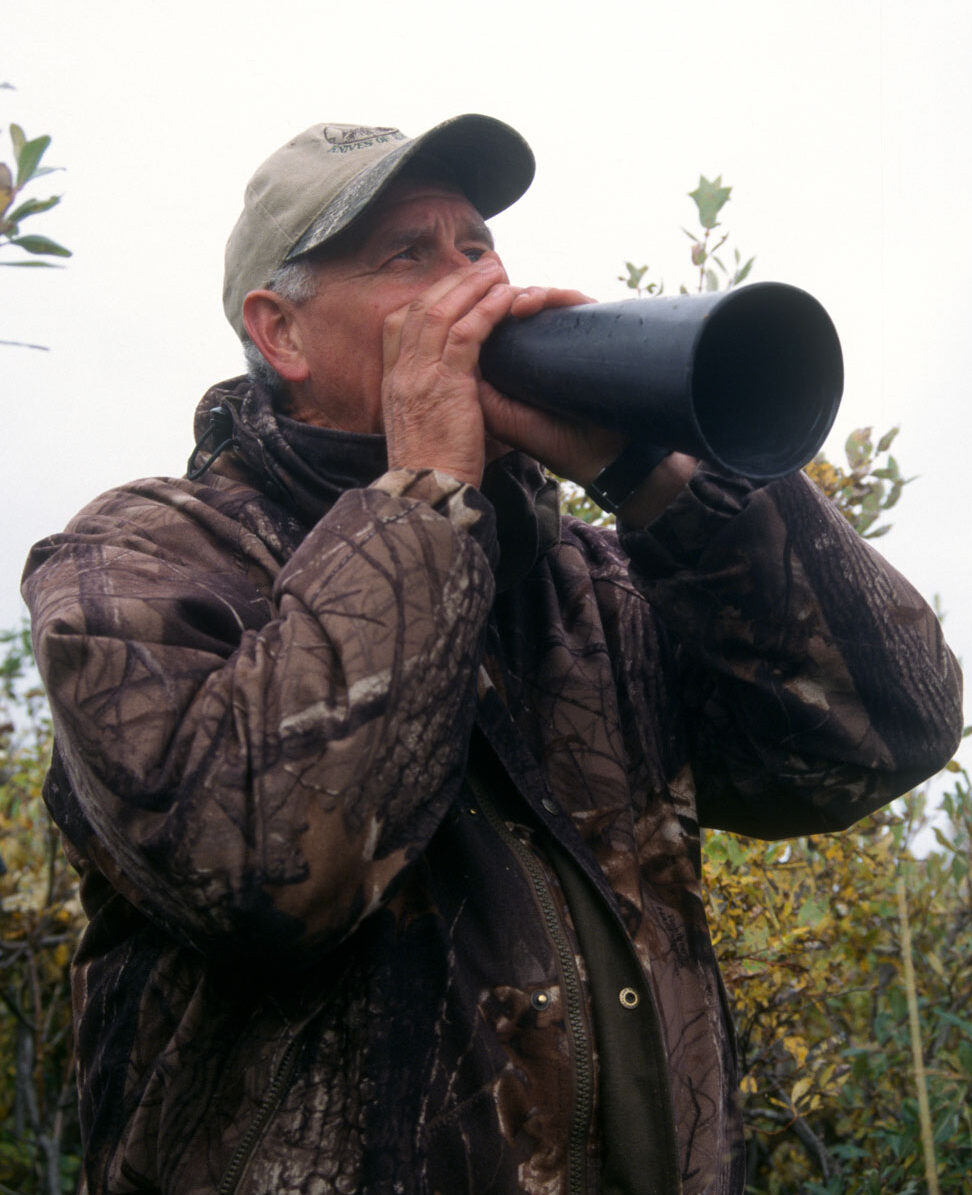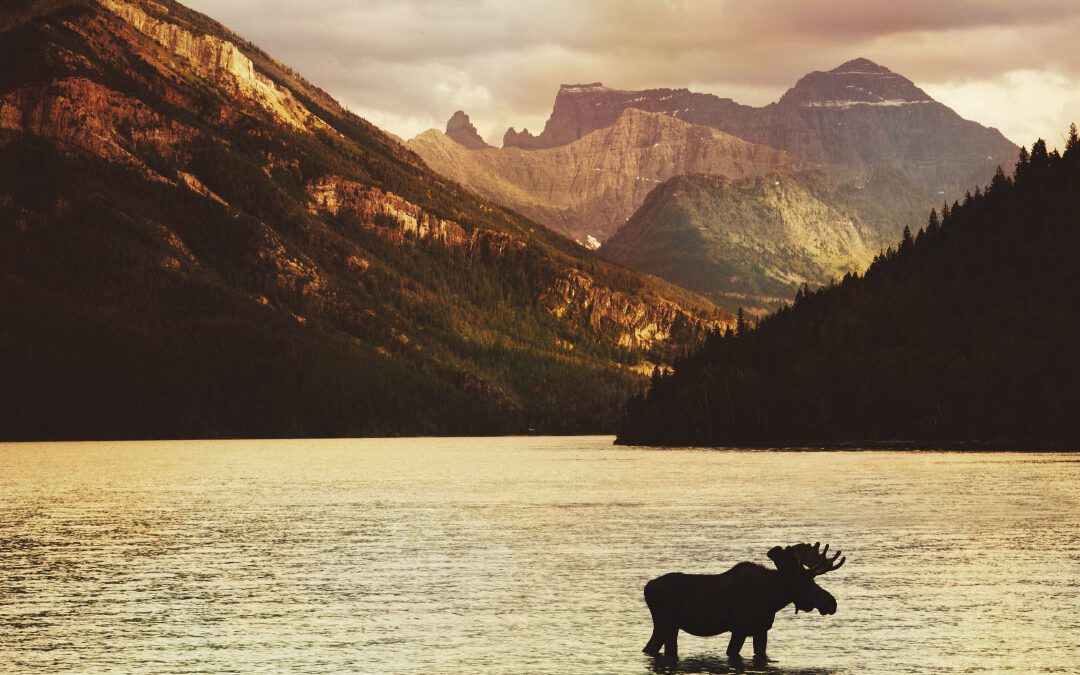I’d been suckered back in. Suckered back to bowhunt moose in Alaska. I should’ve known better. I’d visited Southeast Alaska three times before, culminating in some of the worst hunts of my existence.
My first trip was the worst. A friend and I hunted two weeks as hard as we knew how, trudging through conspicuously clean, nightly refreshed snow for ten days without seeing a moose or even cutting a single track—a very expensive grouse hunt-cum-camping trip. The salmon weren’t even in that year. The obese, chain-smoking pilot from the major Anchorage air-taxi service insisted we’d failed because we lacked proper hunting skills. I asked him if he provided guide services.
On my second hunt in The Last Frontier, we saw moose from the DeHaviland Beaver while circling to slide into a desolate lake. The next morning I edged to within 32 yards of a bull. He was either barely legal or barely not, meaning he was just at or just short of the 50-inch legal minimum Alaska mandates in nearly every area today—at least for non-resident hunters. I passed, not willing to take the gamble.
There was another bull later, a real behemoth, and I just flat screwed that up, and that’s all I have to say about it. Then the weather went to hell, a foregone conclusion in Southeast Alaska, and that, as they say, was that.
The third trip was no better. I’ve bowhunted all over the world, guided big-game hunters in New and Old Mexico 23 years, so you’ll have to believe me when I tell you we put in our time. I did kill a black bear with a recurve bow, and at least the fishing was fantastic on that one. There were some heated, spittle-filled arguments after the hunt regarding billable hours, a near fist fight, and I swore I’d never step foot in Southeast again.
And then I did. And, of course, there I was yet again. But at least that time I had been made to believe.
You see, we saw a bull while flying in the night before the hunt. A big bull, 60 inches or better, in a place our host, Charles Allen, knew how to get to—easily no less.

Charles owns Alaska Expedition Company, a first-class fishing and waterfowling lodge on the Tsiu River (pronounced “Sigh-You,” a native term meaning “place of wind,” a moniker the place would eventually live up to). Allen is also owner of Knives of Alaska. Ted Jaycox, another good friend, had roped me into that foray, back when he still produced a television show for the Men’s Channel called The World of Hunting.
So there we all were, believing we’d kill a moose.
We got into the area of the spotted moose the following morning via a Go-Devil skiff, the nifty mud motor pushing the aluminum boat places I wouldn’t have guessed possible. Trumpeter swans lifted from the still water with raucous slap-slap-slaps, ducks wheeled in tight knots from every cove, the sun coming over the Robinson Mountains first red, then orange, and, all of a sudden, blinding yellow. Coho salmon swirled in every eddy, bulging water before them. In the still air, the ocean maintained a dull background roar.
We hiked up an open valley when the Go-Devil could go no farther, then cut out a high Sitka spruce for a vantage. We scraped and beat trees with a moose scapula to imitate rutting bull antlers on wood or battling for a cow, then pinched our noses and, with cupped hands, issued a series of moans, drawn out long and lonely like. We lingered in the area two hours before moving on to the next suitable vantage tree.
This business of climbing trees as glassing perches was nothing new. It came to me on my first moose hunt, and I thought I was quite the clever fellow. Turns out every moose hunter in Alaska knows the drill: find the biggest spruce in the area. Begin climbing, saw in hand, tunneling through constricting boughs. Upon reaching the top, use the saw to cut out a view and go to work with top-quality binoculars, visually picking apart the surrounding landscape. In a flat world of Sitka spruce, alder, and willow, this is how you find moose. At least this is how you’re supposed to find moose.

I cut out and climbed three such trees that morning. From the tops 60 to 70 feet off the ground, I could see the angry Pacific 15 miles away and Mount Saint Elias, all 18,000 feet of him, standing staunch and regal. The smaller ranges—the Chugach, Wrangell-Saint Elias, Granite Range, Bagley Ice, and Robinson Mountains—stretched away to the east and west as far as the eye could discern, white-topped and spilling glaciers from their flanks, willow and alder and cottonwood crowding their bases and creating a Braeburn apple patchwork of color between darker spruce. A brisk breeze rose, harbinger of the monster storm being promised. It was hard to imagine, stillness in alders below inviting attacking, biting whitesox flies to drill and gnaw.
Rob, one of Charles’ young salmon guides brought along for muscle, and I sat atop adjacent spruce for several hours, watching various sectors of a wide, mostly open meadow. We expected our bull to appear, as this was the direction he and his cow seemed to be pointed nearly 18 hours earlier. But the day didn’t go as planned. I was moose hunting, after all.
We gathered gear and headed toward the skiff, clouds scudding in hurriedly, wind gathering momentum, rain arriving in spurts. The promised Southeast weather had arrived. We picked our way carefully, peeking into finger meadows, watching for distant dark shapes or shining antler palms.
By the time we reached the boat, real weather had pulled in, sprinkling the water surface like rising trout, wind pushing treetops around, burnishing the protected marsh. We backtracked in the skiff and then turned up the Tsivat River, beaching the boat occasionally to inspect open meadows until we could go no farther.
The wind whipped, rain beginning to sting our faces when Charles turned up one last creek, the last before heading home. The Go-Devil pushed the skiff up the tight waterway, over sunken logs and gravel bars. The motor cut suddenly.
Charles pointed. “You have binoculars handy? Check that out for me.”
Where he pointed I noticed a dark spot that turned out to be a small spruce. But I panned slowly, and while at it discovered a barely visible moose. I peered longer and made out antlers of a bull feeding in chest-high alders. The wind was carrying our noise away from him, enabling us to watch him longer and soon call him legal for harvest. There was no doubt.
“Everyone hunker down, and we’ll swing around this bend and move closer,” Charles said. The bull was a half-mile away across treacherous marsh.
The skiff hung several times; we jumped over the sides and pushed it along, then clambered back in once we were underway again. We seemed to travel a good distance, and I was growing impatient. I wanted badly to start my stalk.
We tied off and fought clutching alder, coming into open marsh, knee-deep shrub, and the occasional spruce cluster. The bull was nowhere in sight. He’d vanished—not so inconceivable considering the ocean of head-high alder beyond. I wanted to charge in, hoping for the best. Charles suggested we wait, opting to play it safe.
“He just might come back out,” Charles urged. “If he doesn’t, he’ll be here tomorrow.” So we waited while the weather deteriorated, darkness and cold creeping in.
A cow and calf pair broke out of some alders to our right. They were fleeing something, perhaps a brown bear . . . or our bull. We could only guess. They crossed our bow at 80 yards, running past and pausing 150 yards to our left. They seemed to be testing the breeze. We believed they were scenting our bull.
Charles began thrashing brush with his salvaged moose scapula. I pinched my nose and produced deep grunts through cupped hands, exaggerated calls meant to beat the wind. We watched the brush carefully where the cow and calf had paused to sniff. Rob tapped Charles’ shoulder.
“Isn’t that the moose?” Rob asked innocently, pointing straight downwind a couple hundred yards.
Charles grabbed my bow from me, thrusting a Thompson/Center Encore in .270 Winchester into my hands. I didn’t want anything to do with it. I snatched back my bow, then we ran sideways to keep the wind out of the bull’s nostrils before pausing to look him over. We ducked and moved toward him, then rushed left again, working to cheat the wind, offering more bull grunts to entice him closer. Abruptly he cleared brush, but 60 yards away. Charles offered the rifle again. It was tempting in light of my usual moose luck, but I balked.
“Keep that handy,” I offered. “If things start going south, I’ll use it, but let’s give the bow a chance.” Charles shrugged and produced a cow moan to keep the bull interested.
I dashed 60 yards left to keep the wind working for us, falling behind a clump of brush and nocking an arrow. Charles slid in beside me with the rifle. The bull was still 50 or 60 yards away, facing us. And then he turned, offering his side.
“I’m going to try it,” I said. “If I hit him bad, or miss, I’ll take the gun.”
Bringing the recurve to anchor, I contemplated a range. “Long” was all I could come up with. So I snugged the string into the corner of my mouth, using the broadhead tip as a sight pin, placing the point in the middle of his chest and well into his shoulder to compensate for sure wind drift, releasing half a breath and allowing the string to slip away. The arrow took an arching path, seeming to hang for minutes before plummeting toward the bull on a curve-ball path. It arrived in his side as if by magic, half the arrow still visible, bright red fletchings wagging as he sprinted toward cover.
Charles and I were whooping like banshees, pounding each other’s backs and dancing and jumping in circles like happy children, forgetting the video camera rolling behind us. Meanwhile the bull’s legs had grown unsteady, and he tumbled from sight. Ted wanted some sort of comment for the camera in the gathering dusk, but I was running toward the bull, wildly ecstatic and anxious to see my first bull moose up close.
And he was something to see, his antlers reaching out to 54 inches wide before jutting skyward a couple of feet, heavily palmed, paddles ragged with long, thick tines. But this admiration would prove short-lived as reality quickly set in. Rain was coming down in earnest, and our light was going quickly. Ted shot some quick video footage while I talked excitedly, and then we captured a few hasty stills that later I would be sorely disappointed with.
Charles produced a Knives of Alaska Super Pro-Pack, and we went to work. This was a knife assembly borne of experience, including a heavy Bush Camp Knife for big work, like clearing the area of grabbing alder, a Cub Bear Caping Knife for skinning, Muskrat Skinning/Fleshing Knife for fine work, bone saw, Hunter’s Hatchet to make short work of heavy bone, and diamond sharpening steel, because you aren’t going to get through something as big as a bull moose without stopping to hone your edges. All was contained in a lightweight Cordura nylon sheath. We set to the arduous job of turning the one-ton beast into a pile of meat and hide.
The weather descended like a plague of locusts. A quick decision was made: Charles would make the run to camp for more muscle and pack boards. Ted, Rob, and I began working on the moose.
The hunt was over, but the real adventure had begun.
Charles returned a couple hours later with three additional young men. The rain pounded, the wind making it difficult to walk a straight line. It was black dark. The moose was now a pile of quartered and boned meat, and it was difficult to forget we were surrounded by some of the most aggressive brown bears in Alaska. The skiff was moored only 250 yards from the piled moose meat, but it took us an hour to load the skiff. We were forced to bodily push the laden boat down the narrow, shallow creek, a good half-mile of slogging and shouldering into the reluctant skiff. At the creek mouth, seven grown men clambered atop 800 pounds of moose meat and antlers.
The 18-foot skiff was dangerously overloaded by about four people. Leaving men behind was not an option; the weather had become life-threatening.
We hit the shallow, open area of the marsh as whitecaps began to hit us side-on, the boat taking on water. All of us scrambled to the downwind side of the boat to create more free-board. Charles eased the skiff into the black beyond, yelling directions over the cutting wind for the bright headlight secured over my Gore-Tex hood. I’d just installed fresh batteries and was thankful for that. Everything else we had along seemed to be dying.
There was no way to tell how Charles found his way out of that marsh. Rain was slanting horizontally across my headlight, driving like darts into the side of my face. Visibility was limited to 15 yards as we weaved through spooky channels and more open stretches of whitecaps. The boat had grown unresponsive, the bottom filled with water despite constant bailing. It seemed to go on forever. My fingers had long since turned numb. My body ached from wrestling the bull. It had ceased being exciting. It had simply become something to be endured. Even the youngsters had fallen silent. And then Charles somehow discovered land and the Jeep.

Charles Allen (left) of Alaska Expeditions Company and the author with their moose trophies. Both bulls were taken within a three-day period.
We transferred the meat from the boat into a trailer hitched to the Jeep, stashed the boat, and everyone piled in. Sand blew like white-out snow before a 60-mile-per-hour wind, rain washing the windscreen. And then this man, who had navigated through trackless, endless swamp, lost us on the final stretch. But finally the lights of the lodge pierced the gloom, and then slowly loomed more brightly.
Shelter, dry clothes, food, drink. It had been a long day.

